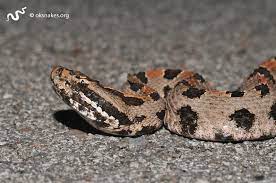These types of snakes are among the more common snakes in east central Oklahoma, along with North American and western diamondback rattlesnakes as well as copperheads and cottonmouth/water moccasins.

Mary Fisher, RN, emergency room and patient experience manager at Hillcrest Hospital Henryetta, said the best way to avoid snake bites is through prevention. Fisher suggested not walking long distances outside barefoot or wearing flip flops.
“We get a lot of bites on the feet,” she said. “You’re less likely to get bitten if you have shoes or boots on.”
For those who garden or work outside, Fisher suggested utilizing a stick as well to help avoid close contact.
“Snakes like to be in dark, shaded places, so if you are working outside and maybe digging in a pile of leaves or dirt, have a stick to move leaves around,” she said. “Snakes love to hide in those areas, even areas where things are stacked up. The color on snakes like the North American rattlesnake or copperhead can blend into the ground and be hard to see.”
Fisher said her best advice is to be alert of your surroundings. Outdoor items like lawn mowers and children’s toys and equipment can also house snakes, so inspecting such items before usage is encouraged.
Determining a poisonous snake from a non-poisonous serpent is also important. Among the differences, Fisher said poisonous snakes feature a triangular-shaped head or oblong eyes, while non-poisonous snakes typically have a circular-shaped head and eyes.
Should a person experience a bite from a poisonous snake, Fisher said they should immediately receive care from a professional health care provider. Home remedy solutions, such as sucking out the venom or a self-made tourniquet, are discouraged.
“Either drive to the hospital or, if you are unable to get there, call 911,” she said.
Tamara Stinnett, director of pharmacy at Hillcrest Henryetta, said patients who experience a bite from a poisonous snake need a specific type of treatment.
“If you are envenomed by one of the locally poisonous snakes, you will need to receive an antivenin as soon as possible to manage and help control the spread of the venom through the body,” she said. “It is best to receive treatment within four to six hours of the snake bite. The patient will receive the first dose as soon as possible, and then will be monitored. Additional doses may be needed.”
 Stinnett said additional medications may also be required to control the pain and any other symptoms the snake bite may cause.
Stinnett said additional medications may also be required to control the pain and any other symptoms the snake bite may cause.“The venom these snakes contain is a mixture of toxins that can effect multiple systems within the body,” she said. “The faster that we can treat the patient with an antivenin, the faster we can stop the spread of the venom through the patient’s body.”
At left is a map showing the general area where pygmy rattlesnaks have been found.














